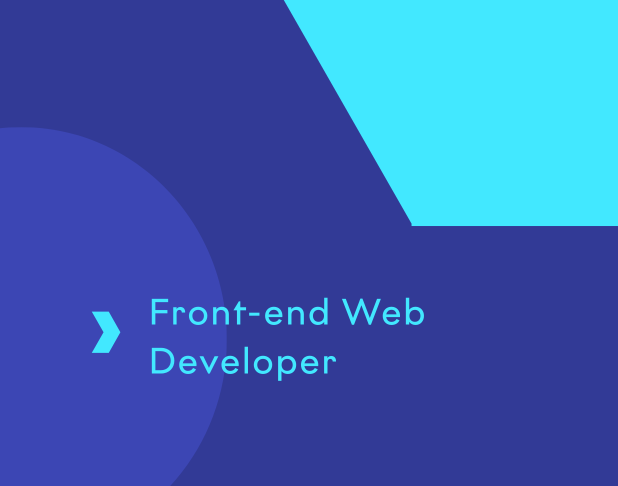Develop your skills to build modern, user-friendly websites that adapt across devices using HTML, CSS and JavaScript. This five-day course equips you with the technical know-how to start working towards a front-end developer certification.
15% off eLearning, up to 20% off virtual courses - use code: EARLY1225USA
Front-end Web Developer
Select your learning method

Build polished, responsive web interfaces
In this immersive 5-day course from ILX, you’ll learn to design and build responsive websites with clean, maintainable code. This course is ideal for anyone looking to gain real-world skills and begin their journey as a certified front-end developer.
- Build mobile-responsive web pages
- Style content using CSS and preprocessors
- Introduce interactivity with JavaScript
- Manipulate the DOM and Web APIs
- Use CSS flexbox and grid systems
- Implement accessibility and SEO principles
- Design and enhance web forms
- Optimise site performance
What you’ll learn
You’ll develop core front-end skills using up-to-date techniques in HTML, CSS and JavaScript. Create well-structured, accessible sites with dynamic features, while exploring CSS frameworks, design patterns and performance optimisation tools.
Responsive Web Design with HTML & CSS
You’ll learn the principles of building structured, accessible web pages using semantic HTML and modern CSS techniques. The course focuses on creating layouts that adapt seamlessly to different screen sizes using flexbox, CSS grid, and media queries. You’ll also work with typography, colour schemes, forms, and multimedia integration to create polished, standards-compliant websites that function well on any device.
Interactive Website Functionality with JavaScript
This course introduces you to JavaScript as the scripting language of the web. You'll learn how to use programming fundamentals - variables, functions, conditionals, loops, and data structures - to add interactivity and dynamic behaviour to websites. By the end, you’ll be able to build user-driven features like toggles, form validation, and interactive elements that respond to real-time input.
DOM Manipulation and Event Handling
A critical part of modern front-end development is understanding how to use the Document Object Model (DOM). You’ll gain practical experience manipulating page content with JavaScript, including selecting, updating, creating, and deleting elements. This up-to-date training helps you develop responsive user interfaces that can adapt on the fly to user actions using event listeners and conditional logic.
Design Principles, Accessibility and Performance Optimisation
You’ll explore essential UI/UX concepts to create websites that are not only visually appealing but also accessible and intuitive. The course covers accessibility best practices and techniques for improving usability, such as keyboard navigation and semantic markup. You’ll also look at SEO principles and performance tuning, learning how to reduce load times and optimise pages for search engines and user experience.
- Five days of live virtual training
- Guided hands-on exercises
- Full course materials provided
- Project-based learning and scenarios
- Support available after the course
- ILX Certificate of attendance
- Industry-experienced trainer delivery
Key facts
Anyone looking to become a front-end developer, including those with foundational programming skills aiming to build professional-grade websites.
Basic understanding of programming principles is recommended. We suggest starting with our Introduction to Programming – JavaScript course if you're new to coding.
Our experienced trainers and interactive labs create a focused, practical environment – so you can put theory into practice from day one.
FAQs
Learn how to design responsive, interactive websites using HTML, CSS and JavaScript. This practical course helps you build job-ready web development skills.
What does a front-end web developer do?
A front-end developer creates the visual and interactive parts of a website using HTML, CSS, and JavaScript. They ensure web pages are responsive, accessible, and user-friendly across different devices and browsers.
Is JavaScript essential for front-end development?
Yes, JavaScript is a core skill for front-end developers. It enables dynamic features such as form validation, interactive elements, and real-time content updates on websites.
How does responsive web design work?
Responsive design uses flexible layouts, CSS media queries, and scalable elements to ensure websites adapt to different screen sizes, from phones to desktops.
What tools do I need for front-end web development?
You’ll need a code editor (like Visual Studio Code), a modern browser (e.g. Chrome or Firefox), and basic familiarity with web inspection tools and version control (e.g. Git).
How do CSS Grid and Flexbox differ?
Flexbox is ideal for one-dimensional layouts (row or column), while CSS Grid handles two-dimensional layouts (rows and columns) with greater flexibility.
What our customers say

“John made the subject matter interesting. The pacing was spot on, and he clearly knew what he was talking about and was able to communicate that easily. Very pleased and would highly recommend.”

“Great course. Alan has been courteous and informative throughout. Highly recommended and will absolutely be coming back for more courses.”
Join the half a million learners developing their skills with our training
A trusted partner to thousands of organisations worldwide
Our passionate team goes above and beyond to support customer needs
Please complete the form to ensure your quote is accurate and we will contact you soon.